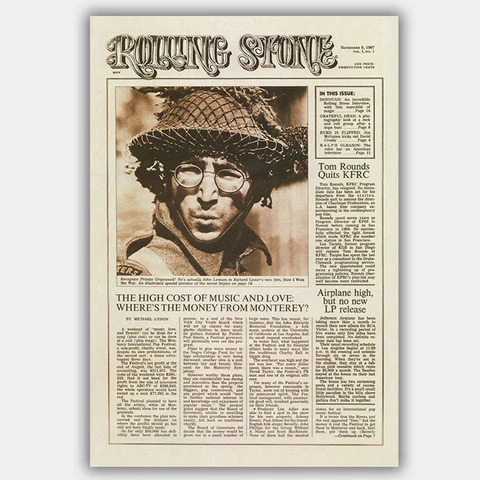About Rolling Stone Magazine

The History of Rolling Stone Magazine
Rolling Stone magazine, founded in San Francisco in 1967 by Jann Wenner and music critic Ralph J. Gleason, has played a significant role in music, politics, and popular culture. Initially, the magazine primarily covered rock music and featured political reporting by Hunter S. Thompson. Its first issue, released on November 9, 1967, had John Lennon on the cover and was published bi-weekly. The magazine was known for its provocative photography and cover photos, often featuring musicians, politicians, athletes, and actors. The publication has been influential in defining significant trends and discerning taste in rock and pop music, with appearances on its cover highly coveted by both established and emerging artists.
In the 1970s, Rolling Stone made a mark with its political coverage, notably with the works of Hunter S. Thompson, including his most famous work, “Fear and Loathing in Las Vegas”. The magazine also helped launch the careers of many prominent authors and journalists. However, the late 1960s and early 1970s saw a shift in the magazine’s focus due to changing music and political landscapes. The deaths of several rock legends and the shifting musical tastes led to a more diverse approach in content.
By the 1980s, Rolling Stone was seen as a literate magazine that covered more than just music, featuring interviews with influential celebrities and contributing to literature and politics. The magazine won awards for its journalism, including its coverage of the Altamont Free Concert and Charles Manson. However, the shift from San Francisco
Rolling Stone magazine, founded in San Francisco in 1967 by Jann Wenner and music critic Ralph J. Gleason, has played a significant role in music, politics, and popular culture. Initially, the magazine primarily covered rock music and featured political reporting by Hunter S. Thompson. Its first issue, released on November 9, 1967, had John Lennon on the cover and was published bi-weekly. The magazine was known for its provocative photography and cover photos, often featuring musicians, politicians, athletes, and actors. The publication has been influential in defining significant trends and discerning taste in rock and pop music, with appearances on its cover highly coveted by both established and emerging artists.
In the 1970s, Rolling Stone made a mark with its political coverage, notably with the works of Hunter S. Thompson, including his most famous work, “Fear and Loathing in Las Vegas”. The magazine also helped launch the careers of many prominent authors and journalists. However, the late 1960s and early 1970s saw a shift in the magazine’s focus due to changing music and political landscapes. The deaths of several rock legends and the shifting musical tastes led to a more diverse approach in content.
By the 1980s, Rolling Stone was seen as a literate magazine that covered more than just music, featuring interviews with influential celebrities and contributing to literature and politics. The magazine won awards for its journalism, including its coverage of the Altamont Free Concert and Charles Manson. However, the shift from San Francisco to New York City in 1977 altered the magazine’s culture, with changes in format and a move towards more market-driven concerns.
Rolling Stone continued to evolve in response to the changing music industry and readership demographics. Facing competition from other music magazines in the 1990s, it expanded its content to include fashion and technology. Despite challenges and criticism, Rolling Stone has remained an influential publication in the music and entertainment industry, adapting to the changing tastes and interests of its readers over the years.

